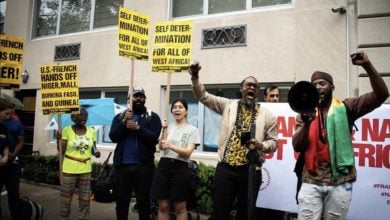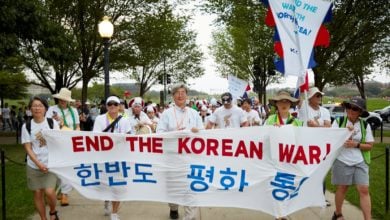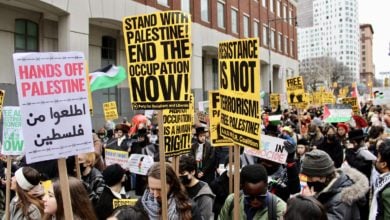According to an Associated Press report on recently declassified records, U.S. military officials gave their consent to mass executions carried out by the South Korean military at the outset of the Korean War.
|
The executions were intended to prevent the victims—thousands of workers, peasants and students who opposed the U.S.-sponsored colonial regime in South Korea—from acting as a support base for the North Korean army.
Within three days of the start of open military conflict on June 25, 1950, the communist-led North Korean army advanced to the southernmost tip of South Korea. They were supported by worker- and peasant-based People’s Committees in the south, which welcomed the North Korean advance.
Hatred for the U.S.-backed South Korean government was widespread. That government had been handpicked by the U.S. military from the former Korean collaborators and puppets of Japanese colonialism.
The cold-blooded massacres of progressive Korean prisoners at the outset of the war has been a major issue for decades in South Korea. Thousands of people were either killed or given long prison sentences for trying to raise the issue of this U.S.-backed bloodbath.
In recent years there has been a nationwide grassroots movement to expose these crimes and to win a measure of justice for the family members who perished. That movement gave rise to South Korea’s Truth and Reconciliation Commission, which is currently investigating the massacres.
The Truth and Reconciliation Commission estimates that at least 100,000 people were killed during the summer of 1950. Kim Dong-choon, historian and chair of the commission’s subcommittee on “mass civilian sacrifice,” believes that estimate is “very conservative,” and could be twice that or more. (Associated Press, July 6)
To date, the commission has processed petitions from over 7,000 South Koreans involving 1,200 incidents; excavated sites at four of an estimated 150 mass graves; uncovered the remains of over 400 people; and officially confirmed two large-scale executions in Cheongwon and Ulsan. In 215 cases, the U.S. military is accused of the indiscriminate killing of civilians, primarily through aerial bombardments. (Associated Press, May 19)
The daunting task of fully uncovering the scale of the slaughter, however, will take years to complete.
Korea divided following World War II
At the close of World War II in 1945, the United States and the Soviet Union arrived at a compromise that led to the division of the Korean peninsula. A Soviet-supported socialist state in the north and a U.S.-backed capitalist state in the south were created. Without that agreement, pro-communist forces would have likely liberated all of Korea.
Syngman Rhee assumed power as the U.S.-backed South Korean president in 1948 and immediately began a reign of terror against everyone involved in leftist political activity. Soviet military forces had withdrawn from northern Korea by 1948. In contrast, tens of thousands of U.S. troops still occupy South Korea today—six decades later.
By 1950, 30,000 political prisoners had been arrested and the National Guidance League—a “re-education” organization for citizens suspected of being communists—had been created. The League’s ranks quickly swelled to over 300,000, filled mostly with poor, illiterate peasants.
In late June 1950, the North Korean military advanced on the South, capturing the capital city of Seoul and freeing thousands of prisoners. Retreating South Korean officials responded with a bloody anti-communist purge, organizing the mass executions of political prisoners, National Guidance League members and anyone suspected of potential collaboration with the North. Most victims were never charged or tried.
In Daejeon, U.S. military personnel witnessed the slaughter of between 3,000 and 7,000 civilians by South Korean military and police. Historian Jung Byung-joon stated, “They were at the crime scene and took pictures and wrote reports.” Bruce Cumings, Korean War historian at the University of Chicago, said, “[T]he U.S. not only did nothing, but covered up the Daejeon massacres.” (Associated Press, July 6)
The mass executions often killed thousands at a time and occurred systematically throughout the summer of 1950. The Associated Press reports that as many as 1,800 were killed in Suwon, 1,000 in Incheon, 4,500 in Daegu and up to 10,000 in Busan. Lt. Col. Bob Edwards, U.S. Embassy military attaché to South Korea, told U.S. Army intelligence that, nationwide, “thousands of political prisoners were executed within [a] few weeks.” (Associated Press, May 19)
Silent complicity
Declassified top-secret documents from the U.S. National Archives indicate that U.S. officials at the apex of power in the Pentagon and State Department had full knowledge of the atrocities, but did nothing to stop them.
According to a 1950 memo, Assistant Secretary of State Dean Rusk responded to questions about the killings by British allies by affirming that U.S. commanders were doing “everything they could to curb such atrocities.” However, action on the ground contradicts his statement.
General Douglas MacArthur, U.S. Far East Commander, had full control over South Korean forces. W.J. Sebald, his liaison to the State Department, informed Secretary of State Dean Acheson that MacArthur considered the massacres a Korean “internal matter” and had “refrained from taking any action.” (Associated Press, July 6)
With a mandate through 2010, the Truth and Reconciliation Commission continues its investigations, studying the thousands of pages of declassified U.S. documents. But with a limited staff and budget, and no authority to summon witnesses or prosecute, the commission faces tremendous difficulty accomplishing its tasks.
The revelation of U.S. complicity in the mass executions carried out by the South Korean military pours salt on the wounds of war, and is yet another reminder of the atrocities committed by imperialism.







